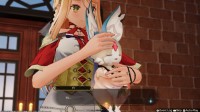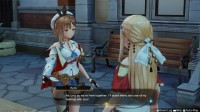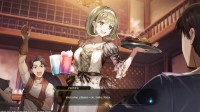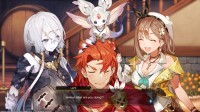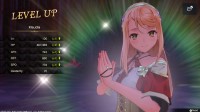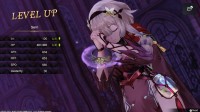Atelier Ryza 2
Playtime: 65.3 Hours
Finished 29 January 2023.Playthrough was done for the main game only, on normal difficulty - this doesn't change any alchemy mechanics as far as I'm aware. I've tried to do most of the side content available to me as I played through the game, which includes finishing all of the side stories for characters like Cassandra/Dennis/Zephine, as well as all of the party members, as well as a number of the side quest chains in this game. All 8 of the available reputation meters have been maxed. I didn't try very hard with Romy's shop development in the merchant district, so levels for lots of item types are still very low. That doesn't actually bother me since I almost never used the merchants anyway. I have all of the DLC, and ended up playing through the Keldorah Castle ruins since they were available (unlocked around the same time as Fairy Forest, I believe) - however, it doesn't seem like Flame Sun Island is available before the postgame, so I haven't done that yet.
As far as crafting goes, I unlocked the entire skill tree with plenty of additional SP to spare (over 30-40K) by the end. I made an effort as early as possible to craft the best possible gathering tools, so I was consistently gathering 100+ quality items by the mid-game, making crafting progression thereafter very smooth. I also crafted extremely high quality versions of most of the field items, with the exception of the fishing rod, which I didn't get around to doing since it required some endgame items. The crafted gear used by my party is at the goldoterion level, accessible in the Underground Mine ruins; these are generally the second-highest tier of item, but the highest tier is only available in the final dungeon - meaning that gold is the best gear for about 3-4 full areas. I didn't want to bother doing a huge crafting session with only about 1-2 more hours to go, so I put a lot of effort into making sure that my weapons, armor, and accessories were extremely high quality; for the main party, they are all at 999 with solid Effects (+ essences) and Traits to boost stats to the moon. They're not perfect but I'd say they come pretty close. On the other hand, core items were slightly more haphazardly crafted - they came out pretty great (especially the Kleid Ice Bomb) and were mostly 999 quality, but are far from the highest tier and could easily be optimized further; I just didn't find it useful since everything died so quickly due to my great gear. I not even close to crafting every item, and I haven't touched any of the DLC items, except for the Innocent Riches accessory that I'm using to put permanent taunt on Patricia & Serri. Lastly, as a side-note - I put some real effort into crafting extremely good Memoria bracelets for Ryza and Klaudia to celebrate their friendship, and since it was an entertaining side objective. It'd be a nice touch if they still had those on in Ryza 3, but I'm somewhat doubtful that they'll add that detail to their designs.
My main party throughout the game was Ryza, Klaudia, and Patricia/Serri; I used Serri for a large portion of the midgame but switched back to Patricia for the last few areas. The entire party (including all of the other unused characters) reached Level 100, but only the main 4 had their core crystal charges and main element affinities fully maxed; Ryza was Ice/Lightning, Klaudia was Wind/Ice, Patricia was Fire/Lightning, and Serri was Fire (no secondary available). Taking into account their levels and particularly their gear, my party statline generally hovers around the 600s-700s for attack, defense, and speed, and mid-400s HP. This was enough to make the final boss look like a chump, the entire fight lasting less than 2 minutes. I imagine that some of the postgame bosses (aside from maybe the last superboss or 2) would also be very easy to take down with my current gear, but I wanted to save a chance to make even more absurd postgame/DLC gear and items before I tackle that later.
I absolutely loved my time with this game, just like I did with the first Ryza game. I'd go as far as to say it's nearly perfect in what I wanted it to be; it's obviously not a AAA game with stunning graphical fidelity but it never needed to be. With the Secret trilogy being more adventure-focused than most of the other Atelier games and slightly less concentrated purely on alchemy, there are some changes to pacing that are naturally divisive since they heavily impact the pacing of the game, but I'm personally very receptive to the way they handled it. When comparing this against the first Ryza game, I'd consider this to be in the minority of sequels that are far better than the first game, and also in an even smaller subset for which the preceding game was also fantastic. The only other example I can really think of is Mass Effect 1 to 2; both fantastic games, but the second still managing to improve on the first.
Seeing as this game takes place 3 years after the end of the first game, there is an off-screen gap in time during which each of the characters has had their own path of character development. I really like the way it was handled in this game, as the main characters (and even some side characters) have significantly changed in reasonable ways throughout over time. Given how the first ended with a pretty happy-go-lucky ending, the re-introduction of the characters in this game hits a perfect balance of making it clear that the characters have clearly grown over time, but haven't figured everything out yet and still have room to grow by the time this game takes place. Tao is busy studying at the academy but is struggling to match the perceived accomplishments of his ancestors, and Klaudia has started taking over some duties for her trading company at the capital but is somewhat nostalgic for a less busy time adventuring with Ryza. Meanwhile, Lent continued his training as a fighter and travels across the world but begins to question his true motives and occupation as a warrior. This is one of my favorite examples of how this kind of character development should be handled, since each character's progression feels like a natural, believable continuation of the previous game and ties these characters very well to the illusion of a larger, breathing world. Contrast this with many other RPGs or franchises in general, which tend to prefer placing old characters into very important roles, which makes it feel like the scale of the world doesn't expand far beyond the main party. Even at the end of the game, despite the bonds between the party and side characters, there is an acknowledgement that they must all move on and continue with their own goals and dreams. The characters aren't inextricably tied to Ryza or to each other arbitrarily (even Klaudia :c - maybe in Ryza 3), which shows a sense of commitment to their growth.
Beyond the evolution of the old characters, I also really liked the new characters (and new designs of old characters) in this game. Returning characters (especially Tao, who wears a hurdy-gurdy everywhere) have been aged up nicely to reflect their paths in life. Lots of the new characters are mostly replacements of similar characters on Kurken Island in the first game, but have their own distinct personality and are all quite likeable, with interesting arcs explored in their side stories. Considering that many of these characters have very limited screentime, they don't really feel like the charicatures present in so many other games. Also, since Ryza is an actual character unlike many other silent protagonists, she feels like a real part in helping the characters, though not to the point of her being the singular point of connection between them. Many important events will have multiple other side characters interact with each other, showing how they grow during their time together as a group rather than in a strange hub-and-spoke tree like in Persona and other similar games. A lot of this goes for the new party members (Patricia, Clifford, Serri) as well - there's not too much to add in the brief commentary here but I like all of them a lot, and feel they mesh well with the returning cast very naturally. Lastly, there's a new "cute mascot" character in Fi, who hatches from a strange egg early in the game. It's a really divisive addition since he doesn't really say anything and some people find him quite annoying, but I personally find him cute and don't mind the addition at all. My only minor gripes are that he doesn't follow you around in the world, and only shows up in cutscenes, where each one his lines (aka voices) takes up a separate dialogue box, which can add some serious padding to scenes. Also, you can't pet him which is a big suck factor too. The other gripe that I have about the side stories in general is how many character events there are, which are all presented in VN-style. They interrupt the core gameplay loop (exploring or crafting) and can frequently stack to the point where I spent 2-3 hours multiple times just watching these events and doing minor tasks/crafting in between. Since a lot of these take place directly in the atelier, they auto-trigger after crafting things which breaks my mental flow somewhat; I really wish there was some way to delay or temporarily disable these without skipping them outright.
The plot in this game is about as simple as the first; Ryza gets a request from Tao to head to Ashra-am-Baird, mentioning some sort of ruins in the area. That pretty much snowballs into being the entire plot, as you meet Fi and learn how he absorbs energy from the crystals hidden in each of the ruins. Naturally the Philuscha are involved again, so by the end of the game (skipping over plenty of details) you basically fight another Demon King to drive them back into the corrupted underworld. It's a simple story, but each one of the 6 ruins has a lot of lore "hidden" in fragments found during exploration, explaning the significance of each set of ruins and expanding on the events of ancient times that led to the downfall of that past civilization. I found the storyline quite interesting, though I wish that the plot events mentioned it more frequently; as it stands, most of the lore puzzles are not actually necessary to complete aside from the ones that give alchemy recipes so the game assumes Ryza just do any of them and can't comment on the backstory of each area. I kind of wish the mechanic was actually required, because the exploring and pattern-matching for lore, while simple, was very entertaining and made uncovering the mystery more fun. The theming of each area's visuals and accompanying music was also universally great, nailing a comfy and relaxing soundtrack that isn't boring to listen to (the horns probably help a lot).
To continue with the non-alchemy mechanics of this game, I think combat is fine. The CC mechanics have been changed to charge during combat, which is very welcome, giving me a real incentive to use items instead of saving them for a few big fights. Since upgrading the core crystal increases initial CC, items can eventually also be used at the very start of combat too, making them universally helpful. However, I really don't like how you can't refuse all drops from a battle. You can still discard the items later of course, but that's still a somewhat annoying QoL issue that cropped up a few times when returning to lower-level areas with bad loot quality. The field items were also pretty cool, but I wish the upgraded fishing rod was easier to craft. They help for things like traversal and gathering options beyond the gathering tools, which return from Ryza 1 and work pretty much in the same way. I wish there were more proper quests though - outside of a few mid-size questlines there wasn't very much, providing little incentive to explore areas thoroughly or get better at crafting, and emphasizing the combat/exploration in this game a little more than the crafting for people who want to try playing this as a pure JRPG. Crafting item quality requirements are low and fights are easy, but many other quests are simply a dialogue event that gives you a reward or skill points for no reason. I think they put too much of it into the bulletin board, but even that doesn't ask for higher quality or harder-to-craft items and focuses more on things you can gather normally. Lastly, the one unequivocally horrible thing about this game is the area map (not the world map - that's fine). There are no markers for elevation changes, nor ladders/vines and some other ineractible objects. There are some one-way slides or paths in this game that are also completely unmarked, and in ruin locations, the map button opens the fragment compass first, requiring an additional button press to see the actual map. It's also kind of weird how you get a full map for a zone as soon as you enter, which robs it a little of the mystery it would have if you had to uncover it manually by exploring. I'd really like for this to get fixed up in Ryza 3, since for some locations in this game the map is pretty much completely unusable.
Finally, to talk about this game's crafting mechanics, which are similar to Ryza 1 but streamlined further, making it easier to reach higher quality items which I quite like. Firstly, there is a new skill tree to unlock new recipes, abilities and increased gather/staff proficiency - I like it since it incentivizes constantly synthesizing things to continue boosting Ryza's proficiency throughout the game. Adding items will never reduce the overall quality of the result, no matter what - it just limits the increase in quality to a lower value. Since this value is no longer a simple average of the inputs, a small number of high-quality ingredients is not guaranteed to produce a high-quality output, which focuses this game more on adding large quantities of items to reach high quality rather than hoarding high quality items for a few good crafts. This system synergizes very well with this game since there is no time limit, allowing you to gather however many ingredients you want from anywhere, but it also makes it a little too easy to reach 999 quality by just passing through a few alchemical transformation layers. A slight downside is that the quality+ material loops are pretty much useless for higher-level crafts now. Between the streamlined crafting, new skill tree abilities, and other new mechanics like essence refinement, reinforcement at the forge, and rebuilding, this game offers plenty of options for some insane min-maxing, which can make it a little overwhelming at times to play through the game casually. There are also tons of different currencies (Cole, Gold Coins, Gems, Core Crystal Fragments, Skill Points, Essence Fragments x5 types) that further make keeping track of inventory difficult. I spent days playing this simply planning out fusions and gathering good materials with desired traits and enjoyed it - but didn't want to do it at every next step or new tier of gear. As mentioned earlier, I found the music really relaxing while playing this game, so unlike many other games I usually just listened to the alchemy music for hours instead of switching over to podcasts or streams during those times.
Despite the expanded and streamlined alchemy in this game, I'm not sure how to feel that most required crafting is very simple in this game, even compared to Ryza 1. I've heard some people say they just finished the game as a JRPG while hardly touching the alchemy at all, which is somewhat disheartening (obviously would be impossible still on higher difficulties) - makes me wonder if it's starting to trend a little too far towards being a standard JRPG. Most required crafting will consist entirely of one or two event items and a small number of other materials - usually things you can gather or synthesize very easily, only reaching up to the neutralizer/zettel level. The hardest quest in this game was probably the one that required 10 lunchboxes, which aren't very easy but far from difficult too. Patty's personal quest also required a super-pure water, but that isn't particularly difficult to craft either, and none of the harder crafting requests have any quality requirement or incentive. There are also plenty of other ways to spend materials - bulletin board requests, selling them to Romy, breaking them down for gems to reinforce or other stuff - which further splits your use cases for gathered items, distracting from the alchemy that forms the heart of the game. Because of this, a lot of the synthesis gameplay is really a create-your-own-fun experience, rather than a requirement for progression; it's weird that they've decided that the entire selling point of the series can almost be optional, since the fights are a little too easy. It's interesting picking up next-items in a dungeon and realizing that the ones I already had were (not exaggerating) over 10x better statwise, as in 200+ attack vs 20 attack. With all the above being said, the postgame still looks like it will be worlds harder than the main story which is promising; the last superboss has something like 10x the health and 6-7x the stats of the final boss in the base game, and will probably require real work to be put into my party to take down. I'm a little burned out of it for now, but I think I'd like to do this before I play the third game.
